Which Animals Were Praised In Ancient Egypt- Wikipedia
Ancient Egyptian Animals
The part of an animal in the modern historic period is primarily that of companionship or food. Older cultures, however, did not ever behold animals in such a manner. In fact, cultures like that of ancient Egypt used some animals for survival purposes, and associated others with gods and goddesses, using them for sacrificial purposes. Certain animals were deified, co-ordinate to their behavior.
Farm Animals
Sheep, goats, cattle, pigs and geese supplied milk, wool, eggs, meat, leather, skins, horns and fat. Some species had associations with sure gods and attributes as well.
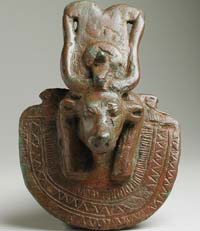
Cattle were an indispensable staple of agronomics in ancient Egypt. The cow was associated with female person fertility and the post-obit gods: Hathor, Isis, Nut, Mehet-Weret and Bat. The bull, on the other mitt, was associated with power, masculinity, fertility and regeneration and the gods Ptah and Osiris. Consequently, the Egyptians often raised and slaughtered cows and bulls in the name of sacrificial offerings to the gods and goddesses.
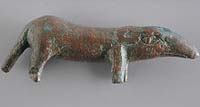
Pigs were associated with Set, the God of Chaos. Ancient Egyptians viewed pigs equally the source of anarchy, cede and calorie-free. They weren't used in religious ceremonies like cattle were. Rather, at that place were primarily used for fat and oil in cooking.
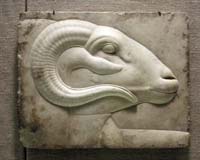
Of the sheep and goat families, the ram received special recognition from the ancient Egyptians. This animal was associated with the gods Banebdjedet and Khnum, and the attributes of fertility, forcefulness and nascency.
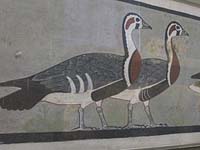
The goose was associated with Geb, Isis and Amon, and its attribute was strength. Eggs were the principal use for geese.
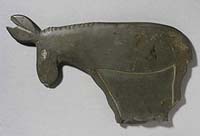
Donkeys were present in processions, hunting and to pull their chariots. Horses were a rarity and a status symbol because they were much more expensive than donkeys.
Wild Animals
Several types of wild animals had religious associations and were used for diverse ceremonial purposes.
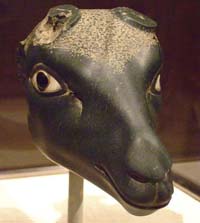
Antelopes were associated with Sokar and carried his royal and overseer attributes. Antelope heads graced the prow of ceremonial boats that stood in temple sanctuaries; this decorative arrangement was considered sacred.
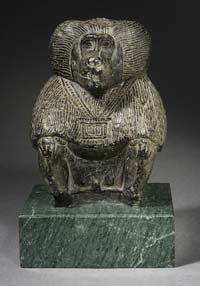
The baboon was associated with Thoth, Khonsu and Hapy, gods that possessed the qualities of eloquence, strength, fairness and responsibility. Thoth was the god who was responsible for the lunar-based calendar and was frequently depicted with the head of a baboon in ancient Egyptian pictographs.
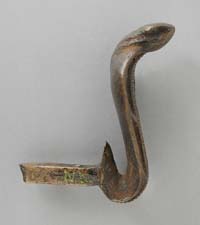
All snakes in general were associated with justice, fertility, protection and royalty and were symbols of resurrection. Nonetheless, the cobra in detail was associated with the god, Wadjet. Additionally, a giant snake named Methen guarded the sacred boat of Re every bit he sailed through the underworld and was a cobra, endearing the species to the Egyptians even more.
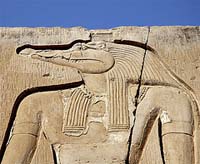
Crocodiles were associated with Amnut, Sobek and Taweret, the gods of justice, power and respect. Amnut was a demon that had the head of a crocodile and ate sinners' hearts for penalisation of their sins. Sobek was depicted as a man that had the caput of crocodile, and temples of Sobek were set throughout ancient Arab republic of egypt and features sacred lakes were crocodiles were fed and cared for.

Frogs were abundant in ancient Arab republic of egypt. Considering there were so many of them, the Egyptians associated them were fertility, resurrection and childbirth and the gods, Heget and the gods of the Ogdoad: Nun, god of water; Amen, god of invisibility; Heh, god of infinity; and Kek god of darkness.

Lions were associated with many gods and attributes, symbolizing strength, leadership, royalty, ferocity, war, healing and beauty. The earth god Aker was depicted equally a double sphinx and was believed to guard the sun as it came and went from the underworld.
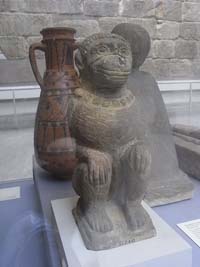
The monkey was revered as one of the well-nigh important animate being forms into which the gods could transform, and they symbolized rebirth and renewal. As such, they were extremely important from a religious standpoint.
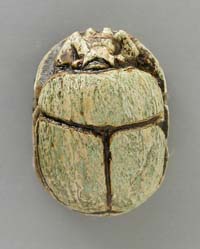
The scarab protrude was special, because it pushed its dung behind it in a brawl, then young scarabs were built-in out of the dung. This fauna symbolized new life and creation to the ancient Egyptians.
Birds
Many species of birds were special to the ancient Egyptians and found their manner into pictograph depictions, statues and other personifications.
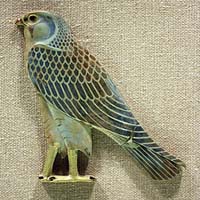
Falcons and hawks were associated with Horus, Montu and Socar, the gods of royalty, protection and strength. Because of this, these gods were often depicted with the head of a falcon, and the pharaoh oft had a falcon with outstretched wings hovering higher up his head on his throne.
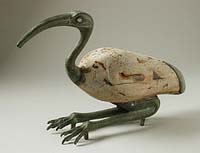
The ibis was a particularly special bird in ancient Egypt, so much so that it was even mummified and buried in tombs and catacombs like cats. This animal was associated with the gods Thoth, Tehuty and Djehuty, and personified knowledge and the soul. This bird was associated with the gods who created magic, writing, were teachers of men and had the power of language.
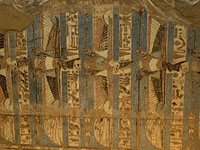
Vultures were figures of protection, associated with Nekhbet and Mut, the gods of eternity, monarchy and leadership. Depictions of vultures were frequently constitute on temple ceilings as a symbol of eternity in the vulture's outstretched talons, offer eternal protection to the pharaoh.
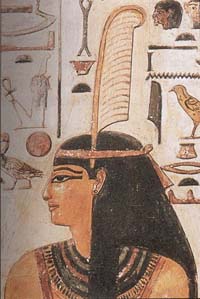
The ostrich personified order and the goddess Ma'at: she was depicted equally a woman wearing an ostrich plumage on her headdress, which is why many Egyptian women wore similar items.
Fish
Fish were sacred to the aboriginal Egyptians considering they were believed to swim alongside Ra's clomp every bit information technology sailed through the underworld, serving as lookouts for Ra'southward enemy, Apep, the h2o snake.
Rilapia and Abju fish were the most special.
Pharaohs and priests were not allowed to swallow fish since fish were said to accept consumed function of Osiris when Set chopped him into pieces and scattered those pieces across the globe. In fact, fish were often viewed as merely fit for consumption by the poorest and everyman people.

© Ashley Van Haeften - Fish Figurine
Cats
Of course, no history of animals in ancient Egypt would be complete without the mention of cats. The true cat was an animal that was particularly esteemed amid the aboriginal Egyptians.

© Doug - Bastet - True cat Sculpture
Not just were cats domestic companions, just at that place were also symbols of the goddess Bastet, and the god Ra. Egyptians believed that cats held some of the most divine powers. Considering cats were seen every bit so tender and protective of their offspring, pregnant women would article of clothing amulets of Bastet with kittens.
Because cats symbolized Bastet, one of the most important goddesses in ancient Egyptian religion, cats were given the rights of mummification, extending them the same respect after death that they were given in everyday life.
They were extremely protected and were so revered that even accidentally killing ane would incur the death penalty. In the event of a burn, Egyptian men would even become then far as to guard the fire to make sure that no cats ran into the flames.
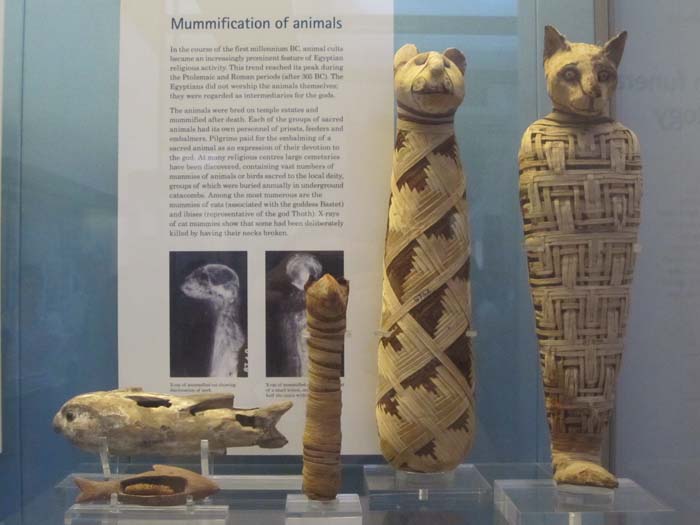
© SpeckledOwl - Cat Mummies
The Worship of Cats
Bastet was known as the Eye of Ra and represented fertility, motherhood, protection and aspects of the sunday. The worship of cats became popular when Bubastis was erected to exist the center of worship for the goddess Bastet.
Thousands of Egyptians would journey to Bubastis every year to pay homage to Bastet, who was personified by the cat. As such, when cats died, they were wrapped in fine linen and transported to Bubastis where they would be mummified and buried in the sacred cemetery.
Dogs
Although dogs were non domesticated in aboriginal Egypt the style they are today, they had their place in Egyptian culture. They were mostly used for hunting purposes, and were considered much lower than the cat. Whereas cats exhibited mystery and aloofness, the utter loyalty of the domestic dog set information technology lower in the optics of the Egyptians, and being called a domestic dog was one of the worst insults imaginable.
Yet, the canis familiaris was sacred to the god Anubis, the god of embalming and mummified. Therefore, dogs were mummified in much the aforementioned fashion as other sacred animals.

© Ashley Van Haeften - Canis familiaris Figurine
Veterinarian Medicine
Veterinary medicine dates dorsum to ancient Egyptian times. Because the Egyptians held so many types of animals in spiritual esteem, they took precautions to intendance for them, serving as "horse-doctors" to prevent animate being diseases.
Egyptians had noesis of beefcake and autopsy for both human and animal mummification. They were also able to diagnose and care for a variety of animal illnesses. Fauna care flourished in Egypt where medical diviners tended to sacred animals, fattening them for slaughter for human being consumption and sacrifices to the gods.
Facts about animals in Ancient Egypt
- Although many of the animals in Egypt were associated with certain gods, goddesses and characteristics, many of them were besides used for practical purposes.
- The main animals found as pets in aboriginal Egypt were cats, monkeys and falcons.
- Some pharaohs even had lions and cheetahs equally pets.
- Regardless of whether the animal was viewed as a sacred ane or not, the Egyptians respected animals and their importance to their survival.
- Daily Life in Ancient Egypt
Source: https://www.ancient-egypt-online.com/ancient-egyptian-animals.html
Posted by: baileythessalky.blogspot.com

0 Response to "Which Animals Were Praised In Ancient Egypt- Wikipedia"
Post a Comment